Chapter XI — Flying Machines Construction And Operation
byChapter XI — Flying Machines Construction And Operation introduces the reader to a vital topic in aviation—how to control the machine with precision and awareness. This chapter goes beyond the mechanical structure and enters the world of real-time decision-making. Flying is not just about lift or propulsion; it’s about command—over altitude, direction, and stability, all at once, under the pilot’s full authority.
The operator is expected to act instantly and with confidence, often making rapid adjustments using levers, wheels, or pedals. These controls affect rudders, stabilizing planes, and even fuel regulation, requiring simultaneous attention to both structure and engine. Early aviators needed to master this complexity quickly to maintain equilibrium mid-air. A minor misjudgment could destabilize the craft or force an emergency landing. The machinery of flight responds directly to these inputs, creating a continuous feedback loop between human intention and mechanical action. This dynamic makes precision not a luxury but a necessity.
Different pioneers experimented with various control mechanisms, reflecting both ingenuity and personal preference. Curtiss, for instance, innovated with a flexible chair-back linked to wing movements, offering a body-driven approach to stabilization. The Wright brothers refined their system from two separate levers to a single integrated control that handled pitch and roll more intuitively. Meanwhile, Bleriot favored minimalism with a single lever setup, and Farman combined lever steering with foot balance controls. Santos-Dumont even used part of his clothing to influence control surfaces, showing the creative lengths to which pilots would go. Each method served the same purpose—control—but was achieved through different routes. These variations helped shape the diversity of early aviation design.
The connection between the control mechanism and the aircraft’s moving parts is often managed using taut wire systems. These wires transfer movement from hand or foot to rudder or wingtip, providing real-time mechanical feedback. While the system is simple in principle, it demands calm, deliberate operation. Jerky or forceful movements can result in overcorrection or mechanical strain. The pilot must stay composed, ensuring each input matches the conditions faced mid-flight. In this context, coordination becomes as important as any structural feature.
No single method of control is presented as universally superior. Each has strengths depending on pilot preference and aircraft design. The chapter instead emphasizes familiarity and consistency. New aviators are urged to become deeply acquainted with their aircraft’s controls before taking flight. This includes hands-on practice while the machine is stationary, simulating control movements to build muscle memory. Understanding how each movement influences the aircraft ensures quicker reactions and fewer surprises in the air. The more automatic the responses become, the safer the flight.
Training on the ground also allows the pilot to detect mechanical issues before takeoff. If a lever sticks or a wire is too loose, these faults can be corrected safely before they become dangerous in the sky. Checking and practicing each movement builds confidence and reduces hesitation when it counts. It’s not enough to know what each control does—pilots must feel it. This tactile learning process transforms theory into instinct. The chapter encourages this preparatory phase as a non-negotiable part of learning.
The variety of methods mentioned showcases the trial-and-error nature of early aviation. There was no blueprint, only shared experience and incremental improvement. With each new design came a fresh approach to balance and maneuverability. This period of innovation allowed pilots to find systems that matched their reflexes and thinking patterns. Some methods faded over time, while others laid the groundwork for today’s standardized control layouts. The diversity of techniques reflects the creativity that characterized the dawn of human flight.
What this chapter ultimately highlights is that success in flight depends on understanding not only the machine but the relationship between man and machine. It’s not the lever or the wheel alone that keeps a craft aloft—it’s how the pilot uses them with awareness and timing. Control systems are only effective when mastered thoroughly and used with judgment. As aviation grew more complex, this foundational skill remained essential. Every great flight began with knowing how to command the machine with confidence, one movement at a time.


